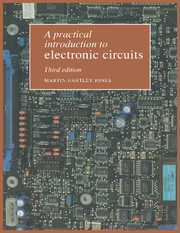Book contents
- Frontmatter
- Contents
- Preface to the third edition
- Preface to the second edition
- Preface to the first edition
- 1 Amplification and the transistor
- 2 The field-effect transistor
- 3 Thermionic valves and the cathode-ray tube
- 4 Negative feedback
- 5 Impedance matching
- 6 Semiconductor device characteristics
- 7 Amplification at high frequencies
- 8 Low-frequency signals, d.c. and the differential amplifier
- 9 Power supplies and power control
- 10 Pulse handling and time constants
- 11 Integrated circuit analogue building bricks
- 12 Positive feedback circuits and signal generators
- 13 Digital logic circuits
- 14 Microcomputer circuits and applications
- Appendix 1 Component identification
- Appendix 2 Transistor selection
- Appendix 3 Op amp data
- Appendix 4 Digital IC connections
- Appendix 5 Interfacing to the PC
- Bibliography
- Index
5 - Impedance matching
Published online by Cambridge University Press: 05 June 2012
- Frontmatter
- Contents
- Preface to the third edition
- Preface to the second edition
- Preface to the first edition
- 1 Amplification and the transistor
- 2 The field-effect transistor
- 3 Thermionic valves and the cathode-ray tube
- 4 Negative feedback
- 5 Impedance matching
- 6 Semiconductor device characteristics
- 7 Amplification at high frequencies
- 8 Low-frequency signals, d.c. and the differential amplifier
- 9 Power supplies and power control
- 10 Pulse handling and time constants
- 11 Integrated circuit analogue building bricks
- 12 Positive feedback circuits and signal generators
- 13 Digital logic circuits
- 14 Microcomputer circuits and applications
- Appendix 1 Component identification
- Appendix 2 Transistor selection
- Appendix 3 Op amp data
- Appendix 4 Digital IC connections
- Appendix 5 Interfacing to the PC
- Bibliography
- Index
Summary
Introduction
The subject of impedance matching is frequently surrounded by an undeserved aura of mystery. When a circuit fails to work as well as expected, impedance mismatch is often blamed in a rather vague sort of way, but correcting the problem may be regarded more as witchcraft than science. The purpose of this chapter is to outline the principles and practice of impedance matching and, in so doing, to attempt to dispel any associations of mystery and magic!
Input impedance
Any electrical device which requires a signal for its operation has an input impedance. Just like any other impedance (or resistance in d.c. circuits), the input impedance of a device is a measure of the current drawn by the input with a certain voltage across it.
For example, the input impedance of a 12 V light bulb rated at 0.5 A is 12/ 0.5Ω, or 24 Ω. The bulb is a clear example of impedance because we know that there is nothing but a filament to consider. The input impedance of a circuit such as bipolar transistor amplifier might seem to be more complicated. At first sight, the presence of capacitors, resistors and semiconductor junctions in a circuit makes the input impedance difficult to assess. However, any input circuit, however complicated, may be resolved into the simple impedance shown in fig. 5.1.
- Type
- Chapter
- Information
- A Practical Introduction to Electronic Circuits , pp. 76 - 122Publisher: Cambridge University PressPrint publication year: 1995



